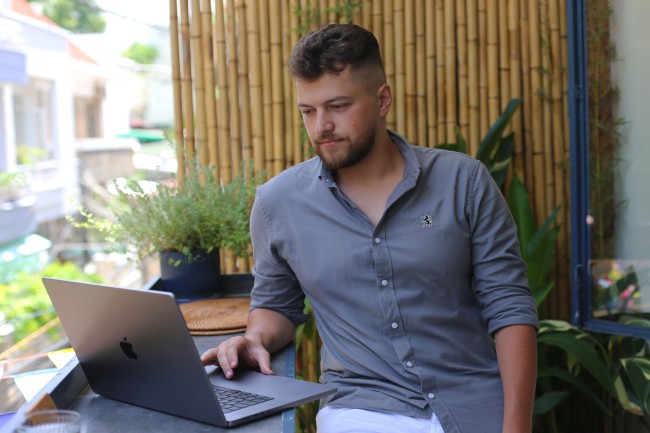
The clicker game market, particularly those launched on the Telegram messenger platform, is valued at $20–30 billion. Every month, hundreds of new clicker games with similar concepts and mechanics flood the market. Amid this competition, the mini-app Fortune Cookies stands out with its engaging mechanics and simple design concept.
Sergei Evdokimov, one of the game’s creators and a senior designer at Aitarget, shared how the game made it to the Trending Apps list, how the team adapted its interface for diverse audiences, and the secrets behind crafting its engaging mechanics.
Tell Us About the Concept of the Fortune Cookies App and Your Role in the Project
Fortune Cookies is an oracle-style mini-app on Telegram that generates personalized predictions. Users fill out a questionnaire detailing their interests, gender, marital status, and geographic data, which the app uses to deliver new “fortune cookies” with predictions daily. This project started as an experiment – we at Aitarget wanted to try creating a mini-app for Telegram, and it turned out to be a success on our first attempt. The app gained popularity, reached the top of the charts, and even received recognition from Telegram without any prompting from us.
The success of this initial phase inspired us to expand the project, leading to the development of Fortune Cookies Coin, a clicker game designed to engage users by rewarding them with bonuses, coins, and boosts that tie back into the main app. These products are interconnected: the clicker serves as a tool for audience acquisition, while the main app collects user data and provides personalized experiences.
As the sole designer on the team, I am responsible for the entire visual graphics and UI/UX. My work begins with conceptual development, where I define the color palette, fonts, interface structure, and visual hierarchy. While the technical implementation, including AI integration, is handled by the developers, I work closely with them to ensure a seamless experience. I create detailed instructions for both the front-end and back-end teams, specifying how screens and elements should function and interact. My goal is to ensure the final product is not only functional but also visually appealing and engaging.
How Does the Prediction Mechanism Work?
When registering, users fill out a questionnaire providing details about themselves. Based on this information, predictions are generated by artificial intelligence, functioning similarly to ChatGPT. Each day, users receive a new “fortune cookie” that can be “cracked open” with a tap of a button. The predictions are saved in an archive, allowing users to revisit them at any time.
The app incorporates gamification elements to enhance engagement: users can invite friends, compete for additional “cookies,” and earn bonuses that connect to the second app. While the general workings are straightforward, the exact details of the algorithms are proprietary and cannot be disclosed.
What Makes Fortune Cookies Coin Stand Out Among Other Clicker Games, and What Design Elements Make It Unique?
Fortune Cookies Coin distinguishes itself with a unique gameplay mechanic and a variety of interactions. Departing from the standard “clicker” model, we designed a multi-scenario game. Players start by “mixing dough,” which then transforms into a living Fortune Cookie character. The cookie is later minted into a coin that drops into a piggy bank. This process introduces varied modes of interaction, from pressing buttons to swiping and collecting falling coins. This diversity keeps players engaged and makes the game more dynamic.
We also added competitive elements like leaderboards for weekly, monthly, and all-time rankings. These features encourage players to return, invite friends, and accumulate achievements. Despite not yet being listed in the Apps Center, the game already boasts over 16,000 monthly users.
As the designer, I analyzed existing game mechanics, compiled their best features, and seamlessly integrated them into our project. Every visual detail – from button placement to the logic behind mode transitions – was meticulously crafted to ensure the game is not only engaging and varied but also intuitive and user-friendly.
Could You Describe the Process of Creating Levels and Game Modes? How Did You Ensure the Game is Engaging and Encourages Users to Return?
We started with the concept of a classic clicker but decided to create something more engaging. This led to the idea of transforming a cookie into a coin. To diversify gameplay, we developed several modes: sequential button pressing, swiping, single taps, and collecting falling coins. These modes alternate to keep the experience fresh and prevent monotony.
We also introduced a leveling system: the more coins a user earns, the higher their level, which allows them to earn more coins per stage. This progression motivates players to advance. Daily bonuses in the form of coins encourage users to return, while competitive elements add excitement, enabling players to compare their achievements with friends.
When designing the interface, I considered how users hold their phones and interact with the screen to ensure the gameplay is comfortable rather than tiring.
Our overarching goal was to create a fun and relaxing game that players can enjoy during their downtime. While we see it, primarily, as a source of entertainment, the option to exchange coins adds an extra layer of reward.

What Role Does Design Play in Encouraging Users to Complete Surveys and Receive Personalized Predictions?
Design plays a crucial role in making the survey process feel simple and appealing. We’ve kept it as easy as possible: users select their interests and provide basic information that’s readily available – such as age, relationship status, and hobbies. The entire process takes about a minute.
The motivation to complete the survey centers on personalized predictions. We visually highlight that each completed field earns rewards—additional fortune cookies. This incentivizes users to provide more information.
From a UI perspective, the elements are vibrant, slightly 3D, and visually engaging. Colorful icons and animations spark interest and draw users in. The UX ensures convenience: the survey is intuitive, and visual cues make the process enjoyable. In this way, the design not only creates an attractive interface but also delivers a motivating and thoughtfully crafted user experience.
What Features Led to the App’s Success – Over 6,000 Downloads Before Release and a Spot in Trending Apps? What Were the Most Effective Design Choices?
The app’s success stemmed primarily from its original concept, which immediately captured users’ attention. At the time, clicker games were just starting to gain popularity, and we entered the Telegram trend at the perfect moment. The novelty and engaging theme naturally drew interest and downloads.
From a design perspective, we emphasized simplicity and clarity in the interface. Even without complex animations, the app looked appealing due to its vibrant and minimalistic design, complemented by charming visual elements like the cookie itself. Although it was a prototype, the test version demonstrated that users were eager to explore new ideas.
The early downloads signaled that we were on the right track. The success of the initial app motivated us to create the next one, which has already achieved even greater numbers. This validates the demand for our concept and prepares us to move forward to the third phase of development.
Our company primarily focuses on collecting and selling cookies (user data), helping advertisers and app owners deliver high-quality ads. Looking ahead, we’re planning a new project – a Telegram advertising platform called Aitarget TMA. Fortune Cookies is actively collecting user data for this initiative. This platform will enable advertisers to target their audience and generate focused traffic from Telegram, while app owners will have a way to monetize their user base.
What Is Your Strategy for Adapting the App’s Interface and Mechanics to Different Target Audiences Based on Age, Interests, and Preferences?
Our approach is built around versatility and flexibility. First, the interface adjusts seamlessly to various screen sizes and supports both Android and iPhone. We’ve also accounted for localization in multiple languages, including Chinese, Turkish, and Arabic. For instance, in Arabic-speaking countries, where text flows right to left, the interface is specifically adapted for user convenience – a feature often overlooked by competitors.
For different age groups, we implemented a universal design approach: large fonts, high-contrast colors, and the option to switch between light and dark modes. These features ensure that the app is equally comfortable for younger users and older audiences.
By prioritizing accessibility and usability, we aim to create an app that caters to everyone – regardless of age, language preferences, or individual needs.
